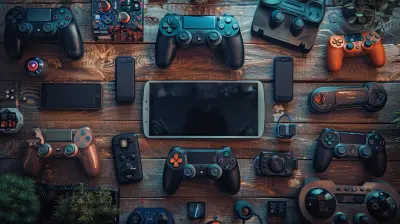The Accessibility of Cross-Platform Games: Opening New Doors for Players
15 June 2025
Gaming has come a long, long way from just couch co-op and LAN parties. Today, we're in a world where gamers aren’t limited by what console or device they own. Instead, you're free to jump into a game with your friends—whether you're using a PC, an Xbox, a PlayStation, or even a mobile device. Wild, right? That’s all thanks to the beautiful magic of cross-platform gaming.
It’s not just a tech trend—it’s literally reshaping how, when, and with whom we play. In this deep dive, we’re going to unpack how cross-platform games are breaking barriers, boosting accessibility, and opening up brand new doors for gamers all over the globe.
What Even Is Cross-Platform Gaming?
Alright, let’s start at the beginning—because not everyone keeps up with gaming tech lingo.Cross-platform gaming (also called cross-play) lets players on different hardware platforms—like Xbox, PlayStation, Nintendo Switch, PC, and even smartphones—play the same game together. You don’t need five buddies who all own the same console anymore. If one’s on PS5, another is rocking an Xbox Series X, and someone else is gaming on their phone? No problem.
It’s the “universal language” of gaming. And honestly? It’s about time.
Why Cross-Platform Gaming Matters in 2024
The whole idea behind cross-platform gaming is inclusion—and that’s something the gaming industry sorely needed. For way too long, your gaming experience depended heavily on what system you owned. If your friends had a different console? Tough luck.But now? That wall’s crumbling. Cross-play opens the door to countless new social and gameplay possibilities.
Here’s why it matters:
1. Gamers Get More Freedom
You can play with your friends, no matter their platform. It’s that simple. You’re no longer stuck buying a specific console just to game together.Want to game on PC while your best friend plays on their PS5? Go for it.
2. Bigger Communities, Better Matches
Cross-play merges player bases from multiple platforms, creating larger communities. That means less time waiting for matchmaking and more time actually playing.Multiplayer games thrive with bigger communities. Think of games like Fortnite, Minecraft, or Call of Duty—cross-play keeps the adrenaline going because there’s always someone to play with or against.
3. Level Playing Field (Sorta)
Okay, let’s address the elephant in the room—yes, there are some differences between platforms. PC gamers often have a slight edge in reaction time thanks to mouse/keyboard setups, but devs are working hard to balance things out.Some games offer input-based matchmaking—so controller users play against other controller users regardless of platform. Fair’s fair, right?
How Cross-Platform Games Are Boosting Accessibility
Now we're getting to the heart of the matter—accessibility.Gaming should be for everyone. But let's be real—it's not always easy or affordable for people to jump into the latest multiplayer experience. Cross-platform gaming is tearing down those walls.
1. Cutting Down on Costs
Not everyone can drop $500 on a high-end console or gaming PC. Cross-platform support gives players more affordable entry points. Got a smartphone or tablet? Boom, you're in. Some games even support cloud gaming, so you don’t need fancy hardware—just a screen and an internet connection.Take games like Fortnite, Genshin Impact, or Rocket League. They’re free-to-play, low-barrier games with cross-play support. That’s accessibility in action.
2. Less Isolation for Disabled Gamers
Cross-platform gaming also matters for gamers with physical disabilities. Consoles offer different types of accessible controllers—like the Xbox Adaptive Controller—which lets players customize their inputs based on their needs.When games are cross-platform, these customized setups don’t have to limit who you can play with. A disabled gamer playing on Xbox with adaptive tech can still team up with a friend on PC or PlayStation. That’s powerful.
3. No More "Platform Lock-In"
Ever bought a game, then switched platforms and had to rebuy it or leave your progress behind? Yeah, that stinks. Some cross-platform games now offer cross-progression too, which means your progress, items, skins, and characters follow you around no matter where you play.That’s not just convenient—it’s inclusive. You’re free to play however and wherever you want.
Popular Cross-Platform Games Leading the Movement
Let’s take a quick look at a few genres—and the big titles in each—that are absolutely crushing it in the cross-platform space right now.🎮 Battle Royale
- Fortnite — Probably the poster child for cross-play. Available on everything short of your smart fridge.- Apex Legends — Cross-play across Xbox, PlayStation, and PC.
⚽ Sports & Racing
- Rocket League — Soccer with cars. Cross-platform since early on.- FIFA 23 — The franchise’s most cross-compatible version yet.
🧱 Creative & Sandbox
- Minecraft — Microsoft’s baby lets you build and play together across PC, consoles, and mobile.- Roblox — Hugely popular with younger gamers and supports cross-platform effortlessly.
🔫 FPS & Multiplayer Combat
- Call of Duty: Warzone — Cross-play has made this game a juggernaut.- Overwatch 2 — Cross-platform matchmaking and progression? Yes, please.
The list is growing every year, and developers are finally starting to realize that locking players in by hardware just doesn’t make sense anymore.
Challenges Faced by Cross-Platform Games (And How We’re Overcoming Them)
Nothing’s perfect, right? As awesome as cross-platform gaming is, it isn’t without its bumps in the road.1. Technical & Compatibility Issues
Different hardware means different capabilities—frame rates, load times, controller types, and even internet speeds. Making sure everyone gets a smooth experience? Not always easy.But developers are getting smarter. Games are designed with scalable performance in mind, so they adapt to whatever system you’re on. Think of it like going from a sports car to a family SUV—you’re still getting to the same place, just at different speeds.
2. Balancing Gameplay
This one’s hotly debated. Mouse vs. controller? Keyboard macros vs. thumbsticks? It’s tricky to balance skill levels. But as we mentioned earlier, input-based matchmaking is helping here. And developers often tweak stats or aim assist options across platforms.3. Platform Politics
The biggest roadblock? Sometimes it’s not the tech—it’s the business side. Sony, Microsoft, and Nintendo haven’t always wanted to play nice with each other. Thankfully, that’s changing. Gamers have spoken loud and clear, and companies are slowly learning to put players first.The Future of Cross-Platform Gaming: What's Next?
We’re just scratching the surface of what’s possible here. The future? Oh, it’s looking bright.☁️ Cloud Gaming + Cross-Platform = Limitless
With services like Xbox Cloud Gaming (xCloud), Nvidia GeForce Now, and PlayStation Now gaining traction, cross-platform is no longer limited to physical consoles or even downloads. You could be playing AAA games on a Chromebook or a TV with zero hardware.🕹️ Unified Gaming Accounts
Imagine a single login that links all your progress, purchases, and friends no matter where you’re playing. We’re seeing steps toward this with Epic Games, Ubisoft Connect, and Xbox Live integration. Expect this to become standard in the near future.🌍 Global Communities, Real Connections
Cross-platform gaming breaks down international barriers too. Different cultures, different languages, same love of gaming. It’s uniting people in ways we’ve only seen in major esports before—but now it’s happening every day, with casual players too.Final Thoughts: Why This All Matters Beyond the Game
So yeah—cross-platform gaming rocks. But it’s more than just convenience or tech wizardry. It’s community. It’s inclusivity. It’s about tearing down walls and connecting players who would’ve otherwise missed the chance to game together.Whether you're a competitive player chasing wins or someone just looking for a chill session with friends, cross-platform gaming is a win-win for everyone.
It’s not just opening new doors—it’s flinging them wide open.
And the best part? Everyone's invited in.
all images in this post were generated using AI tools
Category:
Cross Platform GamesAuthor:

Aurora Sharpe
Discussion
rate this article
3 comments
Marley Simmons
This article highlights the crucial role of cross-platform games in enhancing accessibility for players. By breaking down barriers between platforms, developers foster inclusivity and expand gaming communities. It's an exciting shift that benefits both gamers and the industry alike!
June 20, 2025 at 2:59 PM

Aurora Sharpe
Thank you for your insightful comment! I completely agree that cross-platform games significantly enhance accessibility and inclusivity in the gaming community. It's an exciting time for gamers!
Astranor Wheeler
“Unlocking new realms: who will emerge in this gaming revolution?”
June 16, 2025 at 2:36 AM

Aurora Sharpe
As cross-platform gaming continues to break barriers, we can expect a diverse range of players to rise, including those from traditionally underrepresented groups, fostering a more inclusive gaming community.
Audra Barrett
Great article! It’s inspiring to see how cross-platform games are enhancing accessibility and bringing diverse players together. This progress truly opens new doors for everyone in the gaming community. Keep up the fantastic work!
June 15, 2025 at 2:37 AM

Aurora Sharpe
Thank you for your kind words! I'm glad you found the article inspiring. Accessibility in gaming is truly a game-changer for everyone!



